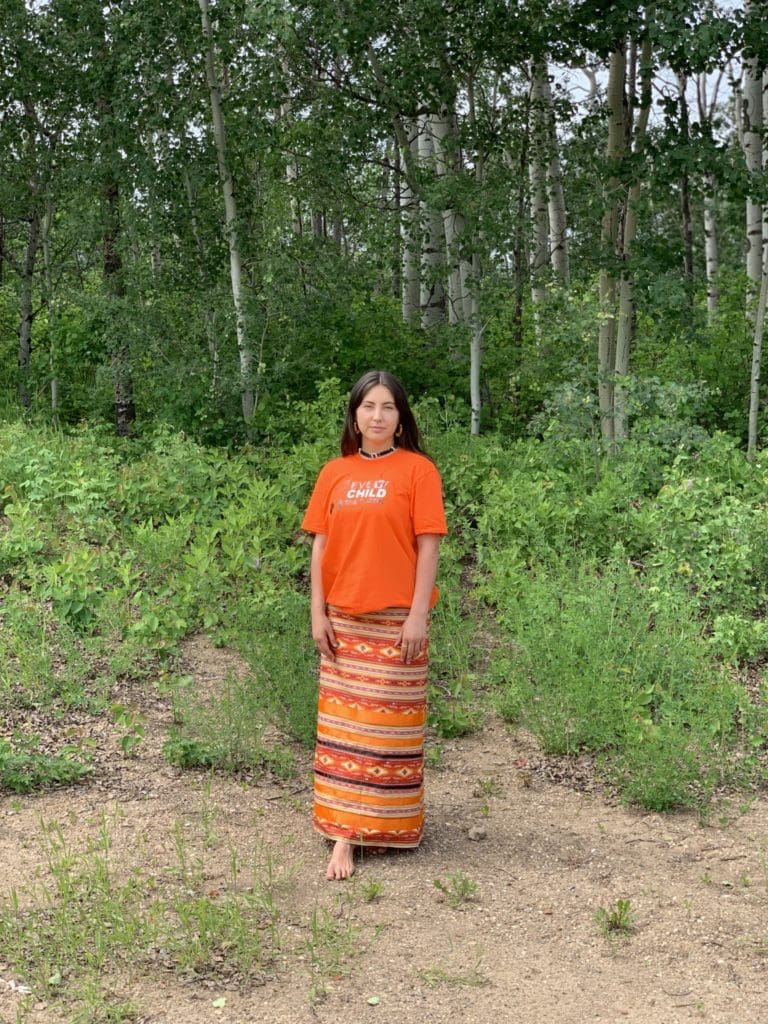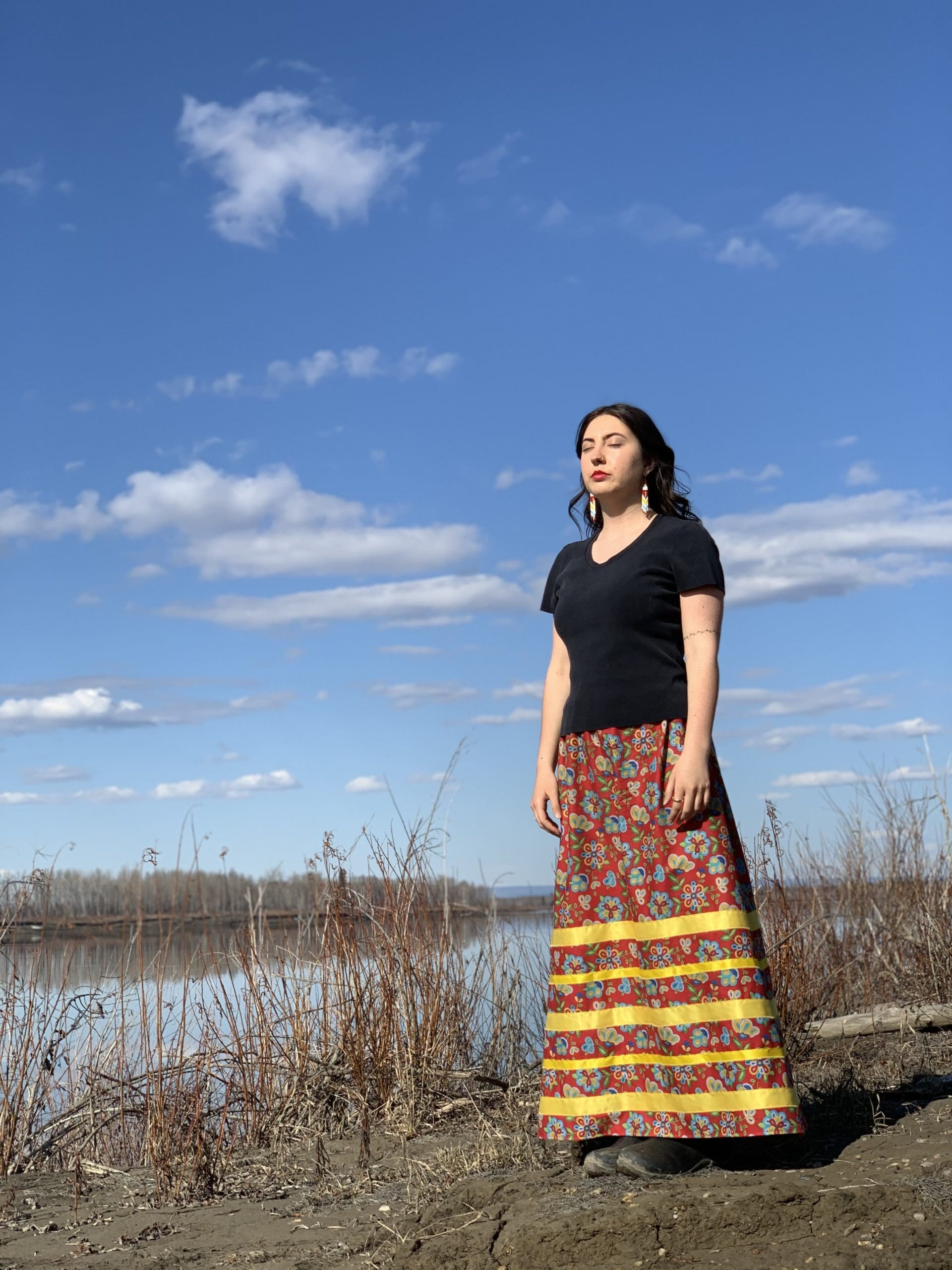Métis Nation of Alberta (MNA) citizen and sustainable business owner Alexa Lizotte, founder of Desert Métis Creations and currently a resident of Port Coquitlam, B.C., is on a mission, to exemplify how her cultural traditions and knowledge can help fight the climate crisis and transform fashion. We spoke to Alexa to learn more. —Noa Nichol

Hi Alexa! Please tell us a bit about yourself to start.
Tansi, my name is Alexa Lizotte and I am a member of the Métis Nation of Alberta. I come from a small, Northern Alberta, Métis community on my father’s side and I also have European ancestry on my mother’s side. I grew up away from my family, community, and nation and today, I share my story of reconnection through my beadwork, sewing, and teaching opportunities whenever available. The Métis Nation of Alberta has been a huge support to me on this journey.
When and why did you launch Desert Métis Creations?
I originally launched Desert Métis Creations to share my beadwork with others. After I finally finished my first beadwork project at the beginning of the pandemic, my beadwork came naturally and I wanted to gift my work to others who may connect to me and my story in some way. Little did I know it would grow into ribbon skirt sewing, beading workshops, sustainability projects, and lectures!
What products/services do you currently offer, and what makes them unique? What niche were/are you aiming to fill?
Today, my focus is on education while sewing and beading for customers in my free time. I think my story makes me unique and allows others to feel comfortable connecting with me. I am not ashamed to shout from the rooftops that I did not grow up embedded in my culture, as this is a common story for many Métis families after the execution of Louis Riel. At the same time, I am also not afraid to shout from the rooftops that I put work into reconnecting to my community each and every day. I believe the strength in my voice allows young Indigenous peoples to be open to my stories, workshops, and lectures and I hope they know they have the power to reclaim their identity too.
Let’s talk about your Métis culture and background; how can Métis traditions and knowledge can help fight the climate crisis and transform fashion?
Métis communities, like many First Nations and Inuit communities, have always held the value of today’s trend, “reduce, reuse, recycle”. We continuously used items that came naturally from the earth, like moose and deer hide for our coats and pants, but we also continuously upcycled items to ensure an item’s full use was expended before laying it to decompose to the earth. A wonderful story of upcycling is the Métis capote, a winter-style coat we saw trending across North America during the fur trade, which was an upcycling of the Hudson’s Bay Wool Blanket that was being manufactured in Europe and traded across North America. Reclaiming and re-acknowledging these values with clothing is a key component in fighting the climate crisis today.
In terms of sustainability and style, which is top of mind these days, what are some ways to make more sustainable and climate-positive wardrobe choices?
The most climate-positive wardrobe choice you can make today is buying cotton, hemp, and linen clothing and avoiding fabrics like polyester and rayon. Fabrics like cotton, hemp, and linen come from the cotton and hemp plants, while synthetic fabrics like polyester are man-made and carry plastic in their fibres, further damaging our land and water. Cotton has a decomposition rate of five months while polyester can take up to 200 years while distributing miniscule pieces of plastic to our sea life. The Ellen MacArthur Foundation estimates that a garbage truck of clothing goes to the landfill every second in the US alone, and because of this, the afterlife cycle of that clothing is important.
How does fast fashion contrast with Métis cultural and historic practices of reusing and upcycling materials, such as food waste and old garments?
Today’s fast fashion trend values abundance while Métis, and many other Indigenous communities, value conservation, relationship, and reciprocation. We have held the value “reduce, reuse, recycle” for generations, adapted from our First Nations relatives and their sustainable use of resources. Unwasteful practices have always been emphasized such as using extra pork fat to make lard, using meat bones to make broth, and re-working old garments to make new garments or quilts. These teachings are wonderful examples of being mindful of your footprint and can be welcomed in your home as well.
What are some hardships faced by Northern Indigenous communities, including your own, because of irresponsible use of resources?
It is frightening to share that spring flooding has become almost a yearly occurrence in my territory. Our Métis community of North Vermilion Settlement saw the first of it in 2018, 150 residents in Fort Vermilion and North Vermilion Settlement lost their homes in 2020, and this year, in nearby Dene community, Chateh, flooding affected over 1,000 residents and evacuated 20-30 families on Métis Settlement, Paddle Prairie. Northern Canada is seeing warming twice as fast as regions down south and it is time to take action.
Can you tell us a bit more about your personal journey empowering community through your business, and work with the Métis Nation of Alberta on flood and disaster recovery?
Empowering my community has come from my community empowering me, it is a reciprocal relationship. I have Métis Nation of Alberta Elders, leaders, and staff who teach me, include me, and support me. It is because of them that I have grown into the voice I have today. I share my story and journey in hopes to help young people across the nation feel empowered in their culture, identity, and community and to feel confident in using their voice. Recently, I was invited by the MNA’s Environment and Climate Change Department to share my knowledge around sustainable living and climate change with Métis community members as part of an Environment and Climate Change Speaker Spotlight, which is part of the MNA’s Climate Change Action Plan. One of the goals of the Action Plan is increasing Métis involvement and awareness of climate change, and I’m honoured to play a role in that process. My work with the Fort Vermilion Métis Local in 2021 was another way MNA has given me a voice and allowed me to aid in empowering citizens after such a devastating flood with 150 people losing their homes. Our flood disaster recovery plan focused on rehabilitation through cultural and community connections. I was lucky to work with community members teaching beading and sewing and assisting other staff teaching land-based education and cultural crafting like making drums. This project was a necessary aspect in the spiritual and emotional healing of the community post-disaster.
What’s next for you, personally and professionally?
Within the next year I hope to start a podcast to help my own, and other, Indigenous voices reach further audiences. Education and connecting with others are my passions and an interview-style podcast marries those two passions together. Personally, I hope to continue my mental health healing journey and continue showing gratitude to my partner, Irshad, my mom, my grandma, and my aunties for supporting me in everything I do.

Be the first to comment